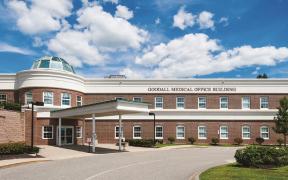MaineHealth Orthopedics and Sports Medicine provides exceptional care for pediatric musculoskeletal conditions in infants, children, adolescents and teenagers. Our experienced team of board-certified and fellowship-trained pediatric orthopedic subspecialists treats every kind of bone and joint problem, from routine to the most complex.
Exceptional care for pediatric bone and joint conditions
We take a multidisciplinary approach to caring for each child, working closely with physical and occupational therapists, bracing specialists (orthotists), neurosurgeons, and neurologists, tailoring care to the unique needs of the individual patient and family. Our patients also have access to the MaineHealth genetics team which provides testing and counseling for children diagnosed with congenital orthopedic disorders.
More about our services
Our pediatric orthopedic surgeons diagnose, treat and manage the full range of congenital and acquired musculoskeletal problems affecting infants, children, adolescents, and teenagers, including:
- Clubfoot (also known as talipes or talipes equinovarus, a condition in which one or both feet are twisted into an abnormal position at birth due to abnormal bone formation)
- Congenital spine deformities such as scoliosis
- Gait abnormalities (limping)
- Hip dysplasia (abnormal development of the hip, resulting in hip joint instability and potential dislocation of the thigh bone from the socket in the pelvis)
- Kyphosis (an excessive round-back deformity seen in teenagers)
- Leg-length differences
- Legg-Calve-Perthes disease (a hip disorder in children due to interruption of the blood supply to the head of the femur – the ball in the ball-and-socket hip joint – causing it to deteriorate)
- Lordosis (“swayback”)
- Osgood-Schlatter disease (“growing pains” of the knee, the result of rapid growth and pulling of the tendons around the knee in adolescents)
- Osteochondritis (inflammation of bone and cartilage)
- Scoliosis (curvature of the spine)
- Spina bifida (a congenital defect in which the spinal column is imperfectly closed so that part of the meninges or spinal cord protrudes)
- Spinal deformities caused by neuromuscular diseases such as cerebral palsy
- Spondylolistheses (a slipping or displacement of one vertebra in relation to another)
- Spondylolysis (a defect in a specific part of the facet joint – the joints that connect vertebrae –called the pars interarticularis; this defect can cause instability in the vertebra, much like a loose hinge in a door)
- Sports-related injuries
- Trauma (fractures, sprains, crush injuries)
Our specialists provide comprehensive diagnostic assessment and expert surgical and non-surgical treatment for the full spectrum of childhood orthopedic conditions including limb deformities such as clubfoot, spinal deformities such as scoliosis, limping, differences in leg length, bone and joint infections, sports-related injuries, and broken bones.
In addition to conducting a comprehensive physical examination and medical history on each young patient, we offer diagnostic resources that include advanced imaging tools. Among these are:
- X-ray
- Computed tomography (CT), an imaging procedure that uses a combination of x-rays and computer technology to produce cross-sectional images (often called slices) of the body
- Magnetic resonance imaging (MRI), a test that uses a combination of large magnets, radiofrequencies and a computer to produce detailed images of organs and structures within the body
- Myelogram, which involves injecting a dye or contrast material into the spinal canal, is a specific x-ray study that also allows careful evaluation of the spinal canal and nerve roots
- Bone scans, a nuclear imaging method to evaluate any degenerative and/or arthritic changes in the joints, to detect bone diseases and tumors and to determine the cause of bone pain or inflammation
- Electromyography (EMG) a test that checks the health of the muscles and the nerves that control the muscles
We offer the most advanced surgical and non-surgical treatments for pediatric orthopedic disorders, including:
- Back and spine surgery
- Limb-lengthening and -shortening surgery
- Surgical repair of tendon and ligament tears and bone fractures
- Joint repair and replacement
- Amputation
- Orthotics, devices such as braces used to support, align, correct or prevent deformities or to improve body function
- Prosthetics (artificial limbs)
- Physical and occupational therapy
- Casting for broken bones





























